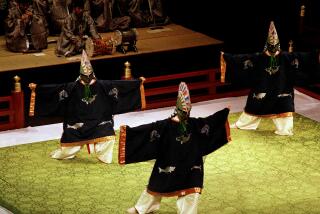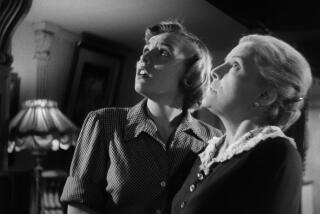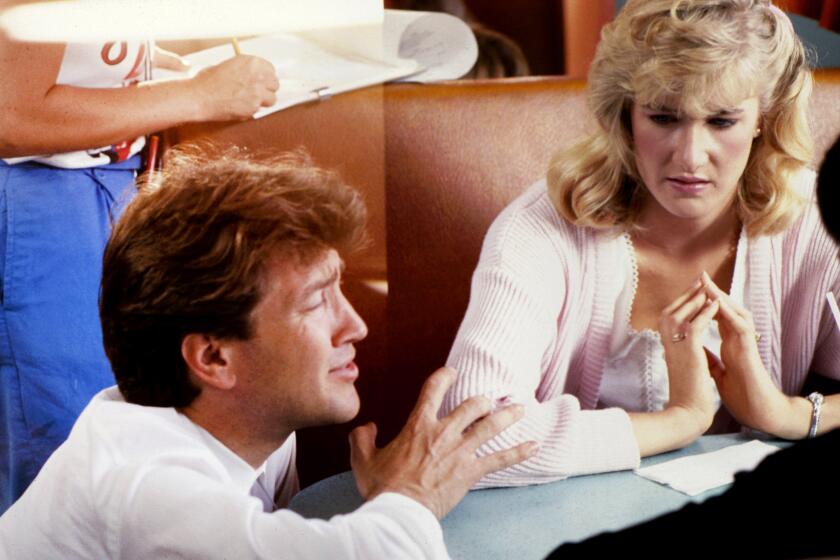A Good- Looking Bunch
- Share via
There is no event like this event, here or anywhere else. The UCLA Film and Television Archive’s Festival of Preservation, currently on a biannual schedule, is back among us with its 10th edition, now more than ever the most exciting and satisfying film event on the Los Angeles calendar.
Opening Friday night with a showing of the documentary “The Times of Harvey Milk” at the Directors Guild and then moving to the UCLA James Bridges Theater in Melnitz Hall, this festival will screen nearly 40 features dating from the 1920s to the 1980s (plus assorted shorts, newsreels and TV programs) before ending on Aug. 26. But it’s not volume that makes this event so special; it’s quality and variety.
Given its title, it’s to be expected that the preservation festival shows its selections in the best prints available anywhere in the world. Black and whites are so crisp they seem ironed, and color is invariably rich and vibrant. When Pauline Kael wrote in 1971 about “The Power and the Glory,” the legendary Preston Sturges-written film that prefigured “Citizen Kane,” she complained that “modern prints are tattered remnants.” What was a fact then is true no longer: An excellent, painstakingly reconstructed print of the 1933 film that made Spencer Tracy a star is a highlight of this year’s festival.
Even more impressive than the print quality is the potent eclecticism of the films UCLA shows. Oddities and classics, famous rarities and unapologetic potboilers, plus overlooked items that fill gaps in film history you didn’t know existed--they all find a home at this event.
Where else could you see Charles Burnett’s poetic 1977 tribute to a Watts slaughterhouse worker, “Killer of Sheep,” and F.W. Murnau’s lyric 1931 South Seas epic “Tabu” on the same program? Other double bills include John Ford classics “How Green Was My Valley” and “The Informer” as well as two from screenwriter Abraham Polonsky, “Body and Soul” and “Force of Evil.” Sam Fuller’s over-the-top “The Naked Kiss” is here, as well as one of the first independent features by a Chicano director, Efrain Gutierrez’s 1977 “Chicano Love Is Forever.”
Among the least known but most innovative films is 1933’s “The Sin of Nora Moran,” directed by Phil Goldstone for Majestic Pictures and starring Zita Johann, formerly the beloved of Boris Karloff’s Mummy, in what at first seems no more than a predictable pre-Code vehicle about how a good girl goes bad through loving too well.
But “Nora Moran’s” storytelling devices are anything but conventional. The film not only makes fine use of stock footage in vibrant montage sequences, but also takes pride in its singular combination of flash-forwards, flashbacks and flashbacks-within-flashbacks. Our heroine is injected with an opiate while on death row (this is pre-Code, after all) and from then on lives in a surreal dream state in which the past and present are so mixed up that she tries to bargain with the other characters in her dream so certain events won’t have to take place. It’s as strange, and unexpected, as it sounds, and it all fits nicely into 65 minutes.
“The Power and the Glory” is on the same bill with “Nora Moran.” The story of a larger-than-life railroad tycoon, it’s told in nonsequential flashbacks, and the way it prefigures “Kane” is remarkable. The film’s coming-attractions trailer called this technique “narratage . . . an idea newer than tomorrow,” and Robert Gitt, the archive’s chief preservationist, laughs and says the heroic job of reconstructing this film should be called “restoratage.”
Especially difficult to get right was a shot of a letter being written by Ralph Morgan, who plays Spencer Tracy’s closest friend: The only surviving version was in French (the film’s dupe negative having ended up in France). Nothing daunted, the preservationists reconstructed the scene with the aid of a vintage inkwell purchased on EBay, a Fox costume last used on “Titanic” and a signature created by Tom Sturges, son of the screenwriter.
Another film that required extensive restoration was the 1927 John Barrymore vehicle “When a Man Loves,” the third film to use the same Vitaphone sound-on-disc system (with the film carefully synchronized to large phonograph records) that later the same year produced “The Jazz Singer.”
Based on the novel that inspired the operas “Manon” and “Manon Lescaut,” this costume drama featuring lots of sword-fighting in tights was considered completely lost for decades. Then, in 1968, Edgar Bergen donated several Barrymore prints that no one knew existed, including one of “When a Man Loves” that had 15 minutes gone. Another print with the missing footage was located in an archive in the former Yugoslavia, and the music for Herman Heller’s rich symphonic score, also considered lost, turned up in a UCLA collection of 2,500 discs. The archive has also reconstructed the three shorts that debuted with the film (including vaudevillians Van & Schenck’s droll version of “She Knows Her Onions”), making it possible to see the entire program for the first time in more than 70 years.
At least two other films in the festival also feature beaucoup swordplay. One is the 1950 “Cyrano de Bergerac,” which won a best actor Oscar for star Jose Ferrer, and the other is the enormously enjoyable 1937 swashbuckler “The Prisoner of Zenda,” starring the exceptional Ronald Colman in the dual role of the King of Ruritania and the English vacationer who looks like him and helps him out of a tight spot. With Douglas Fairbanks Jr. as the king’s evil brother and Madeleine Carroll as the king’s intended, this is rousing entertainment from start to finish.
Also on the same Aug. 26 program with “Cyrano” is one of the festival’s most intriguing short features, a fine collection of screen tests. In addition to Mrs. Patrick Campbell, the actress “Pygmalion” was written for, trying out her cockney accent, there is Katharine Hepburn in a scene from Philip Barry’s play “The Animal Kingdom,” and Group Theatre stalwarts Lee J. Cobb, Morris Carnovsky and Elia Kazan in individual bits. The archive also promises some screen test surprises to fill out the bill.
Among the more rarely seen items in the festival, several are especially intriguing. These include:
* “Noah’s Ark,” directed by Michael Curtiz in 1928. This film, which sees parallels between the World War I era and ancient biblical times, was basically a silent with a few talking sequences added in, but no one came for the dialogue. More than half a century before “The Perfect Storm,” this film set the standard for people literally being swept away in an all-too-realistic flood that reportedly drowned several extras.
* “The Great Flamarion,” a 1945 feature that was an early one for director Anthony Mann and a late one for the legendary Erich von Stroheim, who gives a super-intense performance as a misanthropic vaudeville sharpshooter whose weapons are no match for a woman who says “every bullet is a caress.” Mann later recalled that the actor “drove me mad. He was a genius. I’m not a genius, I’m a worker.”
* “The Home Maker,” an unexpected silent feature, directed by King Baggot but developed by two women, that tells the story, surprising for a 1925 feature, of a man who wants to stay home with his children and a woman who wants to go out to work. On the same bill is 1927’s “The Sensation Seekers,” one of the last films of pioneering female director Lois Weber.
One of the greatest pleasures of the preservation festival is seeing classic films in new prints that reemphasize the qualities that made them so memorable. That happens at least twice this year, with Ernst Lubitsch’s 1932 “One Hour With You” and Budd Boetticher’s 1956 “Seven Men From Now.”
Co-directed by George Cukor, “One Hour With You” is a thoroughly delightful, ultra-sophisticated romantic comedy that almost defines what came to be known as “the Lubitsch touch,” a playful and amused tone about love and sensuality. It stars Maurice Chevalier and Jeanette MacDonald as a happily married Parisian couple who get their vows tested by the arrival of a best friend (the knowing Genevieve Tobin) destined to be remembered, in Chevalier’s words, as “oh that Mitzi.” With Chevalier making frequent asides to the audience, slight misunderstandings get magnified, and the race to romance is on.
Very different in tone is “Seven Men From Now,” directed by Boetticher and written by Burt Kennedy, both of whom are scheduled to appear at the Aug. 25 screening. Starring Randolph Scott, “Seven Men” was the first of half a dozen westerns the granite-faced Scott and Boetticher made together that are collectively known (after the production company that made most of them) as the Ranown cycle. Critics have always loved these films--groundbreaking French theorist Andre Bazin called this one “possibly the best western that I have seen since the war”--and now that UCLA has made it possible to see the result in vivid color for the first time since the original release, that feeling is bound to increase.
Like all the Ranown westerns, “Seven Men” is as concise (only 77 minutes long) and laconic as its star, a weathered man with armor-piercing eyes who stands in a direct line running from William S. Hart through Clint Eastwood. Scott plays Ben Stride, an implacable ex-sheriff hunting the men who killed his wife through a brutal landscape (nearby Lone Pine sitting in for Arizona). As Stride’s outlaw nemesis and all-around leering miscreant, Lee Marvin gives one of the great villainous performances of his career. If you care anything about westerns, this is a film you can’t afford to miss. And the UCLA Festival of Preservation is the only place you can see it the way it should be seen.
(BEGIN TEXT OF INFOBOX / INFOGRAPHIC)
The Schedule
UCLA Film and Television Archive’s Festival of Preservation shows:
Friday: “The Times of Harvey Milk.”
Saturday: “The Power and the Glory,” “The Sin of Nora Moran.”
Sunday: “The Return of Fu Manchu,” “Daughter of the Dragon” at 2 p.m. “Molly O’,” “Feet First” at 7 p.m.
Aug. 2: “Remembering Fred Coe: The Live Television Years.”
Aug. 3: “The Naked Kiss,” “Smash-Up: The Story of a Woman.”
Aug. 4: “When a Man Loves.”
Aug. 5: “The Prisoner of Zenda,” “The Vagabond King.”
Aug. 6: “Minnie to Duke: Animation From the Golden Age,” “The Great Rupert” at 2 p.m. “Cheers for Miss Bishop,” “Someone to Remember” at 7 p.m.
Aug. 9: “Hearst Metrotone News Collection: Newsreel Stories From the California History Project.”
Aug. 10: “How Green Was My Valley,” “The Informer.”
Aug. 11: “The First Auto,” “Noah’s Ark.”
Aug. 12: “Body and Soul,” “Force of Evil.”
Aug. 13: “Hot Water” at 2 p.m. “Sherlock Holmes Faces Death,” “The House of Fear” at 7 p.m.
Aug. 16: “Chicano Love Is Forever.”
Aug. 17: “Big Dan,” “Butterfly.”
Aug. 18: “One Hour With You,” “The Smiling Lieutenant.”
Aug. 19: “God’s Little Acre,” “The Great Flamarion.”
Aug. 20: “Four Frightened People,” “The Painted Woman” at 7 p.m.
Aug. 23: “Killer of Sheep,” “Tabu: A Story of the South Seas.”
Aug. 24: “The Home Maker,” “The Sensation Seekers.”
Aug. 25: “Seven Men From Now,” “Bullfighter and the Lady.”
Aug. 26: “Cyrano de Bergerac,” Hollywood screen tests.
*
All screenings at 7:30 p.m. except as noted. Friday’s screening at the Directors Guild of America, 7920 Sunset Blvd., Los Angeles. All other screenings at the James Bridges Theater in Melnitz Hall on the northeast corner of the UCLA campus, at Sunset and Hilgard in Westwood. For further information, call (310) 206-FILM or https://www.cinema.ucla.edu.
More to Read
Only good movies
Get the Indie Focus newsletter, Mark Olsen's weekly guide to the world of cinema.
You may occasionally receive promotional content from the Los Angeles Times.











